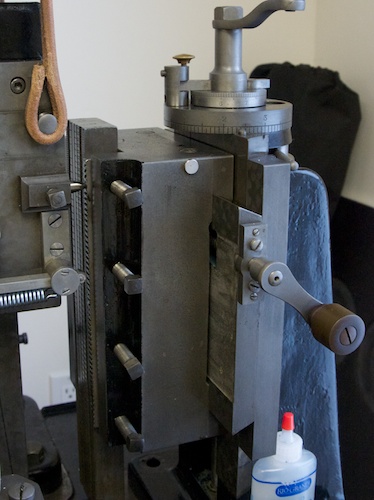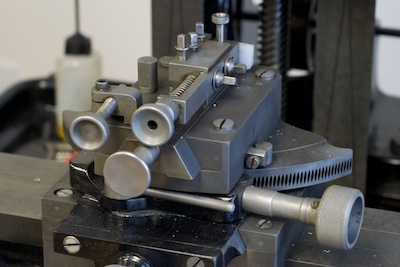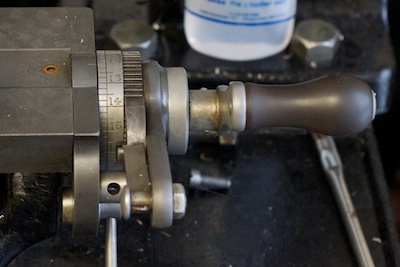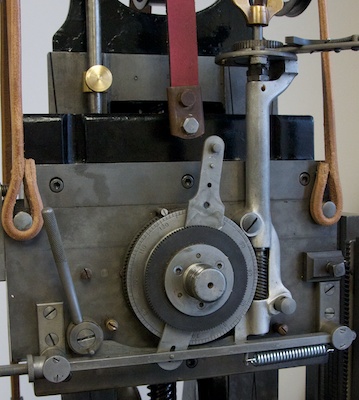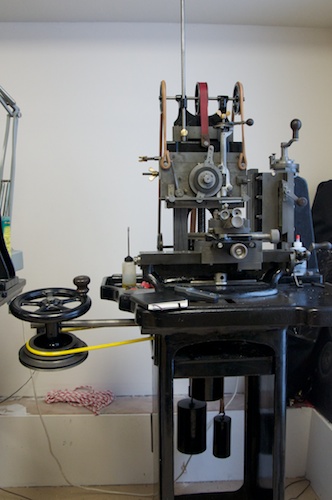
I am sitting in O'Hare airport on my return flight from the 2010 OTI conference in San Jose. OTI is dedicated to the art of ornamental turning, including engine turning. It was great to catch up with some fellow engine turners that I haven't seen in a few years, as well as meet some talented turners who are new to me. One of the conversations that came up regularly was cutter geometry and profiles. The geometry that I am using was proposed by George Daniels in his excellent book Watchmaking, and is appropriate for many non-ferrous metals. I have found this to be the best geometry for brass and silver, and should work well for copper and gold.
The starting point of any cutter is the material of the cutter itself. Traditionally engine turners would have used a high carbon steel, and eventually high speed steel (HSS) for their cutters. These metals will work fine, however, with the introduction of high quality carbide, they have become a little out dated. Last year David Lindow, a clock and rose engine maker in Pennsylvania, turned me on to Micro100 carbide tools. These tools use a micro grain carbide that is exceptionably strong, and can maintain a remarkable polish. I purchase their brazed tools meant for metal turning on a traditional lathe (Travers part# 21-100-907). The square profiled cutters are great as they allow the most flexibility when reshaping for engine turning. Micro100 tools are three or four times the cost of many other brazed carbide tools. The cutter geometry discussed below will work just fine with HSS cutters, or lower quality carbide. Considering the amount of labour involved with engine turning, the additional expense of Micro100 cutters is justified. Each of these cutters will last the lifetime of most engine turners, and the difference in the quality of cut is noticeable. I keep a few cutters for different applications, however, a single cutter will get you started.
The next consideration is the material you intend to cut. Harder metals will require a smaller included angle, while softer materials will require a larger angle. Some experimentation will be required with new materials. I work primarily in silver, and test patterns in brass. Since copper has cutting properties similar to silver, the same cutter should work ok. Moving further away from silver to aluminum (Al) or steel would mean a change in cutter geometry. If you intend to cut Al, maintain a cutter specifically for that purpose. Do not cut silver with the same cutter used for Al. Small amounts of Al remain on the cutter and will affect the quality of cut.
The first part of shaping the cutter is removing a lot of the unnecessary material. Diagram 1 shows in red the initial material to remove. There is no need to have a cutter that is 0.250" wide. None of your cuts will be that wide, and often times it would get in the way. I use a bench grinder to do the bulk of this shaping. It doesn't need to be precise, and you should have approximately 0.060" left for the cutter. Next remove some of the material from underneath the front of the cutter. You will be cutting the front face with a down angle of 10 degrees. There is no need to polish the tool holder. Diagram 2 shows the top and side profile of the remaining cutter. The left side of the cutting face should be made first. I use a side angle of 18 degrees on both sides. If you are working on a softer metal, like Al, try an angle closer to 14. I use a Glendo Accu-Finish for shaping and polishing cutters. It is a great system for maintaining repeatable angles while polishing. Starting with a 240 diamond wheel, work up to 1200. I form the left face right up to right hand edge. Now I switch over to the ceramic wheels and move through 6, 3, 1/2 and 1/4 micron. At each stage check the surface finish under a loop. The 6 micron wheel will remove all visible scratches from the carbide. By the time you get to 1/4 micron, it should look like a mirror. Now go back to the 6 micron wheel and form the right face of the cutter. The distance from the right hand edge to the point should be around 0.015". Work your way up to the 1/4 micron. It is time to form the relief angle. Tilt the table up to 10 degrees. The relief face should be formed only with the 1/4 micron wheel, and does not need to be very large. At most it should be 0.004" wide (about the thickness of a piece of paper). Be sure that the left and right face are the same size. If they aren't, you will get some striations in your cut.
The cutter is now ready to make some chips. If you take care not to drop or chip the cutter, you should be able to just touch it up with the 1/4 micron wheel. It is important that any touch ups be done before the start of a project. Your cuts will look different if you polish the cutter half way through the project.

